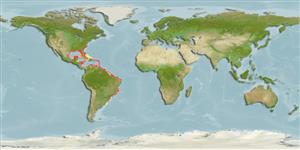Callinectes danae Smith, 1869
Dana swimcrab| Native range | All suitable habitat | Point map | Year 2050 |

|
| This map was computer-generated and has not yet been reviewed. |
| Callinectes danae AquaMaps Data sources: GBIF OBIS |
Classification / Names Common names | Synonyms | CoL | ITIS | WoRMS
Malacostraca | Decapoda | Portunidae
Environment: milieu / climate zone / depth range / distribution range Ecology
Benthopelagic; brackish; depth range 0 - 75 m (Ref. 367). Tropical, preferred 26°C (Ref. 107945); 35°N - 38°S, 98°W - 34°W
Distribution Countries | FAO areas | Ecosystems | Occurrences | Introductions
Western Atlantic: USA to Argentina.
Length at first maturity / Size / Weight / Age
Maturity: Lm 59.5 range ? - ? cm Max length : 13.9 cm CW male/unsexed; (Ref. 367); 11.3 cm CW (female); max. reported age: 2.50 years (Ref. 85497)
Short description Morphology
Carapace slightly more than twice as broad as long; 9 teeth on arched anterolateral margin 9outer orbital tooth and strong lateral spine included) progressively more acuminate laterally; outer pair of frontal teeth (excluding inner orbital angles) prominent but inner pair small. Much of convex dorsal surface lightly granulate, most prominently so on anterior and elevated areas and in transverse lines; central trapezoidal (metagastric) area short and wide (anterior width about 2 to 2.5 times, posterior width about 1.5 times length). Pincers dissimilar, ridged longitudinally; fifth legs flattened in form of paddles. Male with T-shaped abdomen reaching slightly beyond suture between thoracic sternites 4 and 5; first pleopods reaching beyond midpoint of thoracic 6, nearly straight distally except for merabranous tips usually bent ventrolaterally, armed with scattered, minute, mainly dorsal spinules and 2 to 4 subterminal, exceedingly slender, elongate sternomesial spinules. Color: variably olive to greyish blue dorsally, spines olive to indigo and white-tipped; pincers with variable blue to purple on upper and inner surfaces, olive to blue externally; legs predominantly dark blue to azure or greenish, underparts white. Some individuals are duller and some have a reticulate pinkish blue cast on the upper surface of chelipeds.
Minimum carapace width: 3 cm (Ref. 93549). Maximum length of female from Ref. 85497.
Life cycle and mating behavior Maturity | Reproduction | Spawning | Eggs | Fecundity | Larvae
Members of the order Decapoda are mostly gonochoric. Mating behavior: Precopulatory courtship ritual is common (through olfactory and tactile cues); usually indirect sperm transfer.
Main reference
References | Coordinator | Collaborators
Tavares, M. 2003. (Ref. 367)
IUCN Red List Status (Ref. 130435: Version 2024-1)
CITES status (Ref. 108899)
Not Evaluated
CMS (Ref. 116361)
Not Evaluated
Threat to humans
Human uses
Fisheries: commercial
FAO - Fisheries: landings | FishSource | Sea Around Us
Tools
More information
Trophic Ecology
Ecology
Population dynamics
Life cycle
Human Related
Aquaculture profile
Stamps, Coins Misc.
Stamps, Coins Misc.
Outreach
References
Internet sources
BHL | BOLD Systems | CISTI | DiscoverLife | FAO(Fisheries: ; publication : search) | Fishipedia | GenBank (genome, nucleotide) | GloBI | Gomexsi | Google Books | Google Scholar | Google | PubMed | Tree of Life | Wikipedia (Go, Search) | Zoological Record
Estimates based on models
Preferred temperature
(Ref. 115969): 23.3 - 28, mean 26.1 (based on 500 cells).
Resilience
(Ref. 69278):
High, minimum population doubling time less than 15 months (K=1.83; tmax=2.5).
Nutrients : Calcium = 109 [35, 184] mg/100g; Iron = 1.59 [1.21, 1.97] mg/100g; Protein = 20.2 [19.2, 21.3] %; Omega3 = 0.285 [0.185, 0.386] g/100g; Selenium = 48.3 [-31.7, 128.3] μg/100g; VitaminA = 0 μg/100g; Zinc = 1.79 [1.17, 2.40] mg/100g (wet weight); based on nutrient studies.



